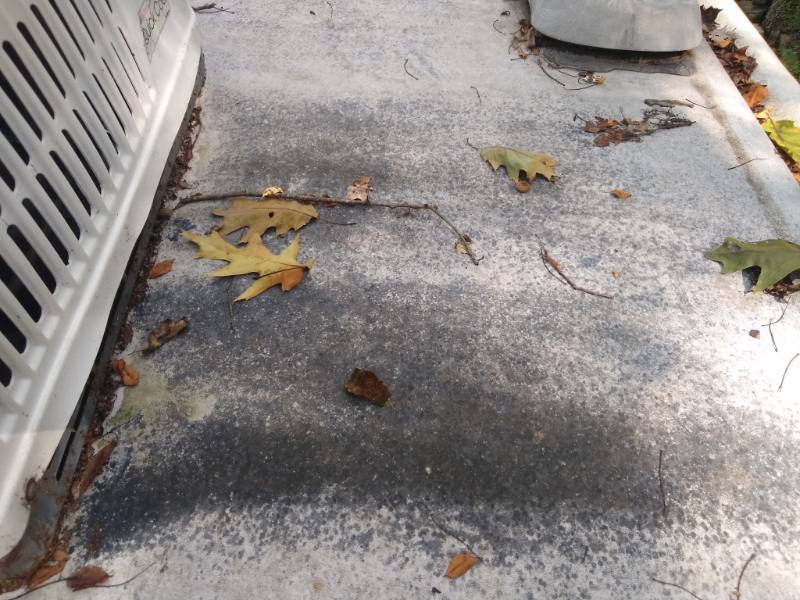If your RV roof is turning black, I’ll bet my hat that your problem is an old EPDM roof at the end of its life. Other possibilities include algae, mold, or air pollution, but a flaky black roof is to an RV what wrinkly elbows are to a human: signs of old age!
Cause #1: EPDM Roof at the End of Its Life

Most RV rubber roofs are made of EPDM, a thin, flexible, plastic membrane. The membrane is actually a sandwich made of two layers: a cheaper black base, and a more expensive white-dyed top. Over time, the white top coating wears and flakes away from UV exposure, exposing the naked black underneath.
There is no “fixing” this problem. By the time your RV rubber roof has turned black, half your roof membrane is gone – literally turned to dust and carried away by the wind and rain! Your roof is almost paper-thin at this point. The black layer is not UV-stabilized; you can’t leave it alone. It will chalk and crack like mad.
You have two options: A) replace your roof or B) recoat your roof. A full recoating is a fancy Band-Aid fix that will extend the lifespan of your old roof by 5-10 years; a new PVC or TPO roof should last another 15-30 years.
Cause #2: Mold or Algae Is Growing on the Roof

If you camp or travel in a humid climate, it’s not a question of if algae or mold will grow on your roof; it’s a question of when. These biological lifeforms feed on the organic dirt that collects in the microscopic crevices in your roof membrane. With a little moisture and sunlight, algae will grow. Take away the sunlight, and you get mold.
Certain membrane types are more prone to algae growth than others. PVC roofs, for instance, tend to be super smooth, while EPDM is more textured. Unfortunately, the textured stuff promotes the growth of algae.
An ounce of prevention is worth a pound of cure. By this time, major manual labor is required. You’ll need to deep-clean your RV roof: rinse, soap, scrub, degrease, rinse, ad nauseum. You’ll either need a medium-bristled brush or a pressure washer, but BE CAREFUL with the pressure washer! It can easily cut through the membrane, sneak under flashing, or cause the membrane to lift off the roof.
Simple detergents, or soap and water, will not kill the mold spores! You’ll need to use a diluted bleach-to-water solution of 1 cup water: 3-5 gallons of water, an anti-mold treatment like Concrobium, or an RV roof cleaner with a fungicide/mildewicide.
Note that it can be VERY difficult to remove stains from mold or algae! If the mold hasn’t been cleaned for several years, you probably can’t make your roof sparkling white again. Just do the best you can.
Cause #3: Air Pollutants Create a Dusty Film
In rare case, air pollutants from industrial plants, volcanic activity, or wildfires can darken your RV roof. Usually, this will show up as a grayish, dusty film, not a black coating. It’s a pesky cosmetic issue, but it’s not damaging to your RV roof.
A simple wash-and-rinse with an RV roof cleaner should take care of the issue. Nothing special is required. Just remember to wet down and rinse your sidewalls as well, or else the dirty roof water will leave streaks.
The best way to deal with an RV roof that’s turning black … is to not let it happen! If you inspect your roof membrane and seals twice a year, you’ll notice any benign problems before they metastasize into something more serious.
Leave a Reply